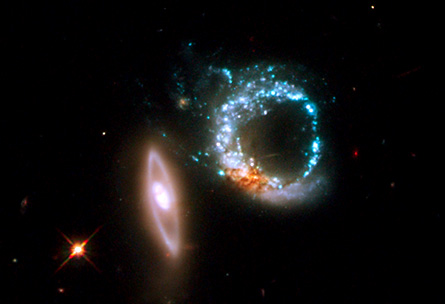There’s good news and bad news about efforts to repair and upgrade the Hubble Space Telescope.
First the good news: Two days after Hubble was brought back to life on October 25, the orbiting observatory’s only working camera took this image of a pair of gravitationally interacting galaxies called Arp 147. The pair lies about 400 million light-years from Earth.
NASA officials say the image, released October 30, reveals that the Wide Field Planetary Camera 2 is working just as well as it did on September 27, the day Hubble fell silent with the sudden failure of a unit that formats and labels data to relay to Earth.
After some initial glitches, engineers succeeded in commanding Hubble to switch to a duplicate unit onboard the craft.
Another science instrument, the Near Infrared Camera and Multi-Object Spectrograph, can’t take pictures, but engineers are optimistic it will be back in action in about five weeks, says Ray Villard, a spokesperson for the Space Telescope Science Institute in Baltimore.
The only functioning portion of another science instrument, the Advanced Camera for Surveys, started operation again October 29.
Now the bad news: A space shuttle mission that would completely overhaul Hubble, and which NASA had previously announced would be delayed until next February, now can’t be launched until May —at the earliest. That’s because a spare data formatting unit on the ground, which the space agency decided must be installed on Hubble as part of any repair mission, isn’t operating reliably. Tests have shown that one of the two redundant electronic pathways on the 135-pound unit functions only intermittently, Hubble program manager Preston Burch of NASA’s Goddard Space Flight Center in Greenbelt, Md., said during an Oct. 30 telephone press briefing. Burch said NASA engineers would spend the next month analyzing the problem.
The unit, formally known as the science instrument command and data handling system, has been stored in a clean room at Goddard since 1991, but had not been subject to rigorous testing before one of the two duplicate devices on board Hubble failed in September. NASA has determined that Hubble should always carry a spare formatter unit, in case one device stops functioning.
Jon Morse, head of NASA’s astrophysics division, said that the space agency had not yet decided whether to cancel the repair mission to Hubble if problems with the formatting unit on the ground could not be corrected. But Burch noted that spare parts for the ground unit exist and that other components could be easily manufactured if needed. Despite some initial electronic glitches, Burch said he is “very confident” that the formatting unit now working on Hubble will continue to operate until the repair mission is ready for launch.








